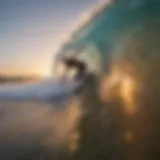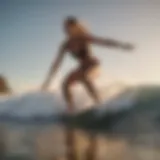The Art and Science of Sand Surfing
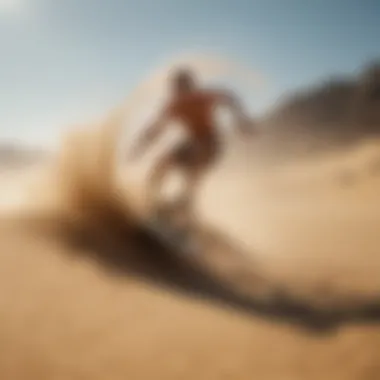

Intro
Surfing has long been about catching waves in the ocean, but a new gust of wind has swept through the surf community: surfing on sand. This distinctive practice offers a whole new way to ride, drawing enthusiasts who are eager for something a bit different. Sand surfing blends the thrill of riding with an entirely new environment, allowing surfers to enjoy what could feel like a beach day every day.
Imagine gliding down sun-kissed dunes, the breeze whipping through your hair, and the soft crunch of sand beneath your board. Surfers on sand are crafting a novel culture, one that brings together camaraderie and competition in places far removed from the ocean. The increasing popularity of this unconventional sport likely springs from people's desire to explore their limits and find fresh, adventurous activities. This guide aims to provide both newcomers and seasoned aficionados with insights and knowledge crucial for enjoying and perfecting this burgeoning discipline.
Prolusion to Surfing on Sand
The emergence of sand surfing marks a transformative chapter in the narrative of extreme sports, offering enthusiasts a fresh avenue for adrenaline-paced adventure. As traditional surfing has long been synonymous with ocean waves, this unique adaptation invites practitioners into a new playground, where sweeping dune faces become the canvas for their skills. Understanding the importance of surfing on sand goes beyond just recognizing it as a pastime; it encapsulates a cultural shift toward dynamic, innovative experiences in the great outdoors.
Sand surfing allows people of various skill levels to engage in an activity that's not only exhilarating but also accessible. Unlike the ocean's limitations regarding weather and tide, sand dunes can often provide a more stable environment for riders. This opens the door for newcomers eager to experience the thrill of surfing without the steep learning curve usually associated with traditional surfing.
In today’s world, where many seek new thrills and challenges, sand surfing has the potential to attract a diverse audience. The benefits range from improved physical fitness and balance to enhanced mental agility as surfers adapt to changing terrain.
Defining Surfing on Sand
Surfing on sand refers to the act of gliding down soft, sandy slopes using specially designed boards, akin to those used in traditional surfing but tailored for a different surface. This form of surfing typically takes place on sand dunes, beaches, or even dry riverbeds, making it surprisingly versatile.
Hailing originally from regions with sizeable sandy terrains, this activity has gained worldwide recognition as a substitute or complement to water surfing. What makes sand surfing distinct is the dynamics involved: the absence of waves creates a different experience, emphasizing balance, speed control, and turning techniques.
Sand surfboards can vary in design, often shorter and wider than standard surfboards, equipped with a smooth, flat base to facilitate gliding over the sand. Riders need to adapt to the unique challenges posed by varying sand textures and slope angles, creating an exhilarating and often unpredictable ride.
Comparing Traditional Surfing with Sand Surfing
On the surface, surfing on sand may appear to be a mere imitation of its aquatic counterpart, but a closer look reveals crucial differences that shape the experiences uniquely.
- Environment: Traditional surfing thrives on ocean waves, dictated by factors such as tide and wind patterns. This requires surfers to learn to read the water, adapting to ever-changing conditions. In contrast, sand surfing predominately relies on fixed geographical features — the aspect of unpredictability lies in the individual sand dune’s shifting properties. Instead of swell patterns, sand surfers contend with varying grain sizes, hardness, and slope steepness.
- Skill Development: Both sports require balance, but the conditions shape the kind of skills a surfer must develop. Sand surfers might find themselves focusing on maintaining speed on flat areas and navigating steep declines, while traditional surfers should concentrate more on paddling, wave dynamics, and pop-up techniques.
- Equipment and Safety: The boards designed for sand surfing have different specifications than their water-oriented cousins. Safety gear is essential in both sports, but the types of gear may differ since the terrain poses different risks. Sand surfers often use knee pads or elbow guards due to the potential for falls on hard surfaces, which differ from the water’s embrace.
- Cultural Context: Surfing has established a rich tradition and community, particularly in coastal regions, whereas sand surfing, often viewed as a novelty, is still gaining foothold. This presents a nascent opportunity for cultural enrichment around sand surfing communities, much like those that have flourished in traditional surfing hotspots.
Understanding these comparisons not only promotes an appreciation for each form of surfing but also invites new practitioners to respect the unique quirks particular to sand riding.
"Sand surfing is like dance on a surface that constantly shifts, testing control, technique, and daring."
As this sport continues to gain traction, it heralds exciting possibilities for blending cultures, traditions, and pushing boundaries in the world of surfing.
Historical Context
Understanding the historical context of sand surfing is vital to appreciating both its roots and evolution. This section highlights how the practice developed, revealing not only the influences that shaped it but also its significance across different cultures. Delving into this context creates a narrative that illustrates the unique characteristics and communal spirit of sand surfing, bridging the past and present for enthusiasts and newcomers alike.
The Evolution of Sand Surfing
Sand surfing is not a mere imitation of ocean surfing; rather, it has its own distinct journey that reflects local customs, geography, and innovation. Its origins can be traced back to various cultures that, with creativity, transformed the experience of riding down slopes into a thrilling sport. In many coastal areas, communities began using smooth boards made from wood or other lightweight materials, akin to snowboards, and repurposed these for sandy dunes.
As the popularity grew, so did the technology behind the boards. People heuristically began honing their craftsmanship, experimenting with different materials and shapes, leading to the diverse range of boards available today. This evolution speaks to the inherent human desire to adapt and explore. In places like the Sahara or Taklamakan deserts, for instance, the local populations innovated their own versions, often using items available in their environment.
In recent history, sand surfing started gaining more formal recognition, thanks in part to social media. Videos showing riders launching off dunes drew attention from thrill-seekers worldwide. As a result, local events were organized, establishing sand surfing as a competitive sport in regions that might have once overlooked it.
Cultural Significance in Different Regions
The cultural significance of sand surfing varies greatly across the globe, illustrating how people interact with their environment and the allure of adventure. For instance, in Mexico’s Huasteca region, sand surfing is more than just sport; it’s a communal activity that brings families together, accentuating bonds and traditions. Riders celebrate their skills during local festivals while showcasing their heritage.
In contrast, countries like Australia have embraced sand surfing as an adventurous endeavor, often combining it with other extreme sports. Here, sandy slopes become a playground for adrenaline junkies, and competitions draw substantial crowds. The event is not just about winning but showcases a culture of camaraderie and collective enjoyment.
Furthermore, sand surfing connects people to nature, offering an appreciation for the unique ecosystems in which it takes place. Riders become stewards of their sandy playgrounds; many participate in projects that promote sustainability, balancing their love for sport with environmental responsibility.
"Understanding where sand surfing comes from adds depth to our experience. It’s not just sand and boards; it’s a cultural tapestry woven from diverse influences."
In summation, the historical context of sand surfing reveals it as an evolving discipline marked by innovation and community engagement. This foundational knowledge enriches the practice, making it not just a sport but a celebration of human creativity and connection with nature.
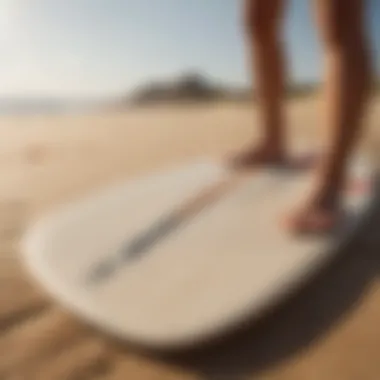

Key Techniques in Sand Surfing
Engaging in sand surfing involves mastering a few vital techniques that help both newcomers and experienced surfers navigate this unique discipline. This section aims to highlight essential skills and maneuvers, aiding surfers in enhancing their performance while ensuring safe practices. Mastery of these techniques not only elevates the experience but also fosters a deeper connection between the surfer and the sandy landscape.
Fundamental Skills Required
To truly get the hang of sand surfing, you need to develop a set of foundational skills. These skills are akin to the building blocks needed for a stable surfboard ride, whether on sand or water. Here’s a closer look:
- Balance: Just like in traditional surfing, maintaining balance is crucial. Sand shifts and can be unpredictable, making it essential to keep your weight centered. A good drill involves practicing on flat terrain before tackling dunes to build your equilibrium.
- Stance: Adopting the right stance goes a long way. Front foot should be aligned near the middle of the board while the back foot provides that extra push. A slight bend in knees helps absorb the terrain’s bumps, mimicking riding over waves.
- Paddling: While you won't be paddling with arms and hands in sand surfing, a proper approach to gaining speed is important. Leaning forward to initiate movement allows the board to glide smoothly over the sand. This motion might feel a bit awkward at first, but perseverance makes it feel more natural.
- Stopping Techniques: Knowing how to slow down or stop is just as important as starting off. You can dig your heels into the sand to effectively control speed, or shift your weight back and rotate to come to a halt gracefully. These stopping techniques also prevent collisions in crowded areas.
One's initial experiences may seem like a steep learning curve, but with grit, progress becomes clear.
Advanced Maneuvers
Once the fundamental skills are securely in your toolkit, it’s time to explore advanced maneuvers that take your sand surfing to the next level. These techniques focus on style, control, and fluidity, allowing surfers to stand out among their peers:
- Carving: This entails making fluid turns, similar to water surfing. By shifting your hips and leaning into your turns, you create smooth arcs in the sand. This adds a sense of grace and style to your ride that can be captivating for onlookers.
- Jumping: A daring move, but exhilarating if executed well! You can initiate a jump off small dunes or mounds of sand, using momentum to launch yourself briefly into the air. Timing is key to land back smoothly on your board without wiping out, so don’t be shy about practicing this with control.
- Grabs and Spins: Taking it a step further involves incorporating grabs (holding the board mid-air during jumps) and spins (turning the body while airborne). As you grow more comfortable with jumping, these tricks can showcase skill and flair.
- Riding Switch: The ability to ride both regular and switch stances adds versatility. Regular stance means left foot forward; switch stance flips this. Practicing in both stances contributes to overall balance and control, giving surfers the edge in competitions.
"Mastering advanced techniques in sand surfing not only elevates your performance but also enriches your connection to this exciting sport."
Through diligent practice and courage, these advanced maneuvers can lead to a superior sand surfing experience. Each technique enhances your skill and enjoyment, nudging you closer to mastering the art of riding down the dunes.
Necessary Equipment
When diving into the exhilarating world of sand surfing, getting the right equipment is crucial for both performance and safety. Unlike traditional water surfing, sand surfing necessitates an understanding of the unique characteristics of the surface and the specific tools that will enable riders to navigate these sandy slopes effectively. The right gear not only enhances the experience but also helps maintain safety while carving through the dunes. This section will detail the essential types of boards and the safety gear required for a thrilling and secure sand surfing adventure.
Types of Boards for Sand Surfing
Selecting the appropriate board is probably the most significant decision for any sand surfer. Several types are specifically designed to accommodate the nuances of sand, giving riders the ability to glide smoothly down slopes while executing tricks. Here are some popular options:
- Sandboards: Similar in design to traditional snowboards, sandboards typically have a wider stance and a smooth bottom to reduce friction with the sand.
- Skimboards: These boards are shorter and lighter compared to sandboards, perfect for those who enjoy leaping off dunes and gliding along the wet sand at the beach's edge.
- Ski Sleds: An unconventional option, these sleds allow surfers to sit down while engaging in descending rides. They work well on softer surfaces and provide a unique approach to riding.
- Custom Boards: Some enthusiasts will choose to design their boards, often incorporating features like personalized graphics or specific dimensions that fit their style of riding.
- Types of Sandboards: Some are equipped with straps for better foot control, while others are simpler, catering to those who prefer a freestyle approach.
- Versatility: Skimboards can also be used in shallow water, making them a versatile choice for those who switch between the beach and sandbox.
- Stability and Ease: Perfect for beginners who may feel uneasy standing up right away.
- Personal Touch: Not only do custom boards set you apart, but they can also enhance your performance if tailored correctly.
Choosing the right board can transform a rider’s experience from frustrating to exhilarating. Therefore, it’s invaluable to test different types if possible, finding one that matches your comfort and style.
Safety Gear and Accessories
Safety should always be at the forefront of any extreme sport, and sand surfing is no exception. While the landing may seem soft, injuries can occur, which makes appropriate safety gear indispensable. Here’s what every sand surfer should consider:
- Helmet: A good helmet protects your head against any falls or collisions. Lightweight options that allow for ventilation are available, so there’s no excuse to ride without it.
- Knee Pads and Elbow Pads: These pads safeguard against scrapes and bruises that can happen when tumbling through loose sand. Look for ones that offer adequate padding, but aren't too bulky for comfortable riding.
- Wrist Guards: Many sand surfers forget about wrist protection, but these guards can save you from injury if you take a spill or get caught in an awkward fall.
- Sunglasses or Goggles: Protecting your eyes isn’t just about comfort; it's about safety too. Strong winds or flying sand can irritate your eyes, and a good pair of goggles offers a solution.
- Gloves: If you're using a sandboard, gloves may help improve grip while navigating your ride, especially when conditions turn a bit gritty.
"Safety isn’t just a precaution; it’s a commitment to yourself and the sport. Gear up, stay smart, and enjoy the ride!"
With the right equipment and gear, you'll be set to enjoy the thrill of sand surfing while minimizing the risks. By understanding the types of boards needed for performance and ensuring safety with appropriate gear, enthusiasts can embrace this dynamic sport with confidence.
Locations for Sand Surfing
The significance of locations in the realm of sand surfing cannot be overstated. The right spot offers not only the physical terrain suitable for this unique sport but also a vibrant community and an enriched experience for enthusiasts. Locations dictate the potential energy of a surf, influencing the adrenaline rush and the skill challenges a surfer might encounter. From monumental dunes to serene beaches, the geography shapes the approach and spirit of sand surfing itself.
Popular Destinations Worldwide
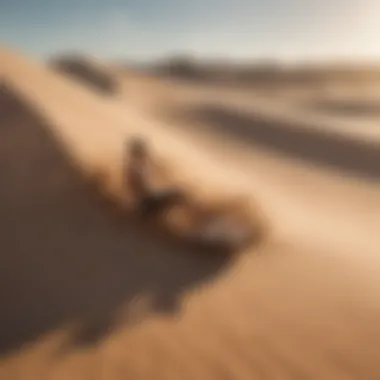

When it comes to sand surfing, some areas have earned their stripes as bonafide global hotspots. These destinations are not just popular due to their sandy landscapes but also for the unique atmosphere and culture they offer. Here are a few noteworthy locations:
- Oman’s Liwa Oasis: Known for its towering dunes, this spot attracts sand surfers who want to experience vast stretches of sand. The heat is a challenge, but the thrill is unmatched.
- California’s Pismo Beach: A classic for sand surfing, Pismo offers accessible dunes and a welcoming community. It’s particularly suited for beginners, making it an ideal starting point for novices.
- The Dunes of Ica, Peru: The stark, dramatic landscapes provide a backdrop that is nothing short of breathtaking. The slopes here offer an exhilarating ride that keeps the adrenaline junkies coming back.
- The Sahara Desert: For the adventurous spirit, the Sahara hosts some of the most formidable dunes. Although this would require planning, the experience is something that remains etched in memory.
Each of these locations provides not just the physical space but a community of like-minded individuals and events that foster the culture of sand surfing.
Understanding Local Conditions
To fully embrace the thrill of sand surfing, understanding local conditions is crucial. Each location comes with its own unique set of challenges:
- Sand Texture: The nature of the sand greatly influences how one rides. Fine, powdery sand can lead to faster rides, while coarse sand might require more effort and could slow you down.
- Weather Patterns: Wind can affect stability on the slopes. Learning about local wind conditions will aid surfers in selecting the best times for optimal performance.
- Seasonal Changes: Some locations might be better during certain times of the year. Understanding high and low seasons can drastically influence the surfing experience.
- Safety Precautions: Local wildlife, heat considerations, and the potential for sudden weather changes can pose risks. Knowing the local hazards ensures a safer and more enjoyable experience for all surfers.
This awareness not only elevates the activity to new heights but also deepens the connection between the surfer and the environment.
Community and Culture
The intertwining of community and culture within the realm of sand surfing cannot be understated. It lays the groundwork for enhancing not only the individual experience but also fosters a vibrant spirit among participants. In an era where digital connection often overshadows personal interactions, engaging in sand surfing provides a tangible way for enthusiasts to bond over shared passions and adventures. These gatherings do not just serve as platforms for competition; they cultivate friendships that often extend beyond the sandy slopes.
Sand Surfing Events and Competitions
Sand surfing events and competitions play a pivotal role in shaping the culture surrounding this exhilarating sport. They do more than merely showcase talent; they create a sense of belonging amongst surfers. Events like the Sandboard World Cup not only bring together top athletes from various backgrounds but also introduce newcomers to seasoned pros. The adrenaline-filled atmosphere of a competition can be infectious, drawing in those who might be on the fence about trying the sport.
Moreover, these events often feature various categories, such as speed runs and freestyle competitions, allowing different skill sets to shine. Local competitions can also serve as a launchpad for surfers aiming for greater recognition and sometimes even sponsorship deals. Importantly, they create a marketplace for vendors, offering products from custom boards to stylish apparel, thus expanding the industry's reach.
As the saying goes, "the more, the merrier." These events often feel like community reunions, where surfers share tips, tricks, and tales of their experiences. Friendships are formed over shared rides down the dunes, painting a rich tapestry of camaraderie.
Building Local Communities
Local communities are the lifeblood of sand surfing culture. They provide a framework for sustainable engagement and often serve as hubs for knowledge transfer. In many regions, small groups form clubs that focus on improving skills, organizing outings, and setting up maintenance protocols for designated surfing spots. Such initiatives not only promote the sport but also encourage responsibility toward the environment.
Engaging in sand surfing can bridge gaps between different demographics. Take the example of the club 'Sand Riders Unite.' This group, formed in a small coastal town, has attracted members ranging from young children to retirees, all drawn in by the exhilarating challenge that sand surfing presents. The diversity of participants enriches the community's overall experience, where wisdom mingles with youthful enthusiasm.
Activities organized by these communities may include workshops for beginners, showcasing safety measures and board techniques. In the process, they build a knowledge base where everyone feels comfortable asking questions, regardless of their skill level. This further enhances the community spirit and creates an environment where members feel valued.
"In sand surfing, it’s not just the adrenaline that pulls you, but also the connections you build along the way."
By investing time and energy into local communities, enthusiasts both enrich their own experience and contribute to the long-term sustainability of sand surfing as a culture. Each participant brings their own flair, enhancing the overall narrative while also welcoming newcomers into the fold. Thus, the synergy of surfing on sand thrives, underpinned by an engaged and passionate community.
Environmental Considerations
When diving into the realm of surfing on sand, the environmental aspects can't be ignored. Just like waves reshape a coastline, sand surfing has its own ecological footprint. It’s essential to analyze both the potential impacts and sustainable practices that can help mitigate any negative consequences. Let’s peel back the layers of this topic to see how sand surfing interacts with our environment and how enthusiasts can practice responsibly.
Impact on Coastal Ecosystems
Surfing on sand can influence coastal ecosystems in varied ways. While it might seem harmless at first glance, consider the following points:
- Disturbance to Flora and Fauna: Sand dunes are dynamic ecosystems that serve as habitats for many species. Unregulated sand surfing can lead to the trampling of native plants, which in turn affects the entire food chain.
- Erosion Concerns: Just like traditional surfing can affect wave patterns, sand surfing alters the movement of sand, potentially speeding up erosion in certain areas. Dune stability is crucial for maintaining the coastal landscape.
- Pollution Risks: The gatherings of sand surfers can lead to litter and waste, harming local wildlife. What was once a pristine area can quickly turn into a dumping ground if proper measures aren’t taken.
To encapsulate, understanding how sand surfing affects ecosystems helps ensure that this thrilling activity doesn’t come at the cost of our natural habitats.
"The health of coastal ecosystems is intricately linked to the activities we participate in. Sand surfing can either preserve or harm these delicate environments."
Sustainable Practices for Sand Surfing
With great fun comes great responsibility. To embrace sand surfing in an ecologically friendly way, here are some sustainable practices that enthusiasts should consider:
- Choose Low-Impact Locations: Selecting areas specifically designated for sand surfing can minimize the adverse effects on sensitive environments. Make sure to research locations that are more resilient to human activity.
- Leave No Trace: Carry out what you bring in. This old adage rings true—avoid leaving behind trash, including food wrappers and gear remnants. Respect the environment to keep it pristine for future surfers.
- Participate in Clean-Up Events: Join forces with others in the community to organize coastal clean-ups. Not only does this benefit the ecosystem, but it's also a chance to bond with fellow sand surfing enthusiasts.
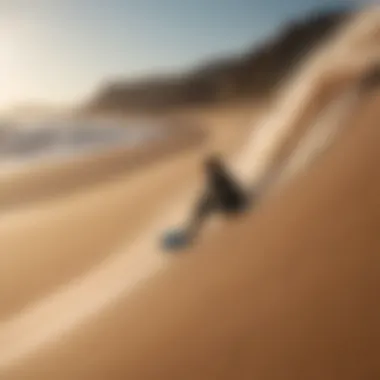

By integrating these sustainable practices into the lifestyle of sand surfing, enthusiasts can contribute positively to their surroundings. Enjoying the thrill doesn’t mean we can’t also act as stewards of the earth. With conscious efforts, the vibrant community of sand surfers can thrive while protecting the beauty of our coastal ecosystems.
Health Benefits of Sand Surfing
Incorporating sand surfing into one’s lifestyle offers more than just an adrenaline rush; it provides a plethora of health advantages. Understanding these benefits is crucial, especially for those eager to explore this exciting discipline. As the sands shift beneath the board, so too does an individual's health experience a transformation. In this section, we delve into the physical, mental, and emotional benefits derived from engaging in sand surfing, emphasizing its significance in promoting holistic wellness among enthusiasts.
Physical Benefits
Sand surfing engages multiple muscle groups, providing an intense workout that can rival even the most rigorous gym sessions. Here’s how:
- Core Strength: Maintaining balance on a moving board requires substantial core engagement. The constant adjustment to movement not only strengthens abdominal muscles but also enhances overall stability, which is crucial for many sporting activities.
- Leg Development: Paddling on sand and maneuvering the board up and down dunes work wonders for the legs. Squats, lunges, and shifts in weight can build leg muscles, improving both strength and endurance.
- Cardiovascular Health: Sand surfing is a great calorie-burner. The physical exertion involved elevates heart rate, which improves cardiovascular fitness. Over time, regular participation can lead to lower blood pressure and improved circulation.
- Bone Density: The exposure to weight-bearing activity helps in maintaining and increasing bone density. Regular sand surfing can combat conditions like osteoporosis, especially as one ages.
In summary, the physical benefits of sand surfing can lead to a healthier body and a more active lifestyle, making it a fantastic alternative to traditional exercises.
Mental and Emotional Aspects
Sand surfing does not just sculpt the body; it significantly boosts mental and emotional well-being as well. Here are some key considerations:
- Stress Relief: The rhythmic nature of surfing offers a meditative effect. Riding down dunes with the wind in your hair can wipe away the stress, akin to a refreshing breath of fresh air.
- Sense of Community: Engaging in sand surfing often involves social interaction. Whether it’s participating in local events or simply hanging out with fellow surfers at the beach, the camaraderie developed can alleviate feelings of loneliness, creating a supportive community.
- Boosted Confidence: Mastering new skills in sand surfing enhances self-esteem. As individuals conquer challenging slopes or improve their techniques, they foster a sense of achievement that translates into various aspects of their lives.
- Connection with Nature: Surfing brings an individual closer to nature. The sensation of sliding down a dune under the sun evokes appreciation for the environment, promoting mental wellness and mindfulness.
In essence, the mental and emotional benefits are as vital as the physical ones. They create a well-rounded experience that fosters a love for the sport and an enhanced quality of life.
By prioritizing health through sand surfing, individuals can truly immerse themselves in this thrilling sport while reaping significant rewards across their physical and emotional spectrums.
Future of Sand Surfing
The tide of excitement surrounding sand surfing is only going to rise in the coming years. As more enthusiasts are drawn to this exhilarating sport, understanding its future signifies a broader appreciation for what sand surfing can offer. This section casts a spotlight on how trends and innovations could mold the fabric of this activity, while also recognizing its vast potential for global acceptance.
Trends and Innovations
Sand surfing is breathing fresh life into the realm of extreme sports. A notable trend is the use of technologically advanced materials in equipment design. Boards made with lightweight composites, which allow for improved agility and speed, are hitting the market hard, transforming how the sport is played. New shapes are also being experimented with. These are aimed at optimizing performance based on various sand conditions, ensuring that every surfer finds something that feels just right.
Moreover, there’s a surge of interest in electric sand surfing. Boards equipped with small motors are becoming increasingly popular. This innovation enables surfers to glide over sand dunes with added ease, especially when they are tackling steeper inclines or shallower surfaces. The thrill of acceleration now extends onto sand, allowing for maneuvers that were previously difficult without pure physical effort.
Additionally, virtual reality (VR) is making waves too. Experienced surfers are utilizing VR to simulate conditions before they hit the dunes, which enhances their adaptability and skills. This technology not only provides immersive training but also broadens access—those unable to reach sandy beaches can practice techniques in a controlled environment.
Potential for Global Expansion
As the interest in sand surfing continues to swell, so does the opportunity for growth across various continents. Regions previously overlooked for surfing can now be considered potential hot spots. Think of the vast deserts, towering dunes, and unique landscapes just waiting to be discovered. The Middle East and parts of Africa, for example, are beginning to catch the attention of climate-conscious surfers looking for alternatives to traditional coastal spots.
One major consideration for this expansion involves infrastructure. Developing suitable facilities for both enthusiasts and newcomers is essential. Bringing in rental shops, coaching programs, and competition venues will not just enhance the experience—it can turn quiet locations into destinations.
Furthermore, local cultures and communities can greatly benefit from this growth. With new spending bringing in tourism, local businesses stand to gain and unique cultural exchanges become possible. Combining local traditions with sand surfing practices could lead to an extraordinary blend of experiences, enhancing both the sport and community narratives wherever sand surfing takes root.
The journey of sand surfing isn’t just about the sport, it’s about what it brings to diverse cultures, economies, and communities worldwide.
As trends evolve and global expansion paves the way forward, the future of sand surfing looks promising. Enthusiasts should be excited about what lies ahead—be it technological advancements, novel locations, or enriched cultural experiences waiting to unfold.
Closure
The significance of this article lies in weaving together the multifaceted dimensions of sand surfing, an activity that merges thrill and environmental consciousness. Sand surfing, while still in its infancy compared to its oceanic counterpart, opens the door to a rich tapestry of experiences that echoes with a sense of freedom and adventure. Understanding its nuanced journey— from basic techniques to the complex interplay between ecology and surfing culture— equips enthusiasts with a comprehensive grasp of what this sport entails.
Reflecting on the Journey of Sand Surfing
Reflecting on the history and evolution of sand surfing reveals how much more than just a leisure activity it is. It embodies a spirit of exploration and connection with one's surroundings. The roots of this discipline trace back to humble beginnings, often sparked by creative minds in regions with vast sandy expanses. Many have felt the call of the dunes, drawn by the idea of carving through grains instead of waves.
Despite the playful nature of sand surfing, it's imperative to acknowledge that it is steeped in local traditions and beliefs. Each region that has embraced sand surfing adds its unique flavor, influenced by culture and landscape. As one glides down a sand dune, there's a distinct echo of the history embedded in that motion. The journey is not just the physical act of riding but also resonates emotionally and spiritually with those who take part.
Encouragement to Explore this Discipline
For those intrigued by the idea of sand surfing, an open invitation awaits. The sport provides a unique intersection of nature, fun, and physical challenge. It's an opportunity to escape typical routines, to exchange the sound of crashing waves for the soft whisper of sand beneath your board. Sand surfing accommodates varying levels of experience; both novices and seasoned athletes can find joy in this discipline.
To start, a simple board, suitable safety gear, and an adventurous spirit are all one needs to hit the dunes. Various communities and events foster camaraderie among surfers, creating an environment ripe for learning and growth.
As the trend continues to expand, it's essential to pursue sustainable practices and respect local ecosystems. After all, nurturing the environment ensures that future generations can also experience the thrill of sand surfing. So, why not give it a shot? Grab a board, head to your local dunes, and start your sand surfing journey today.
